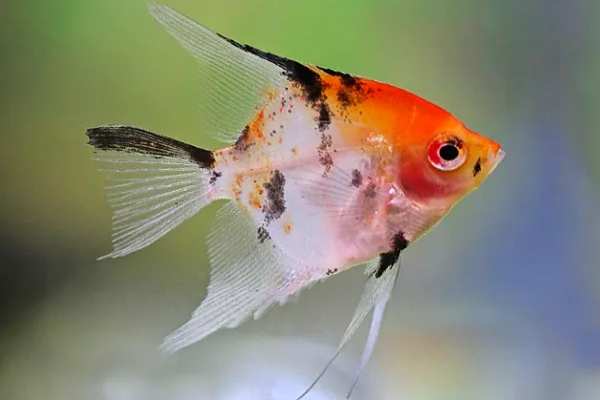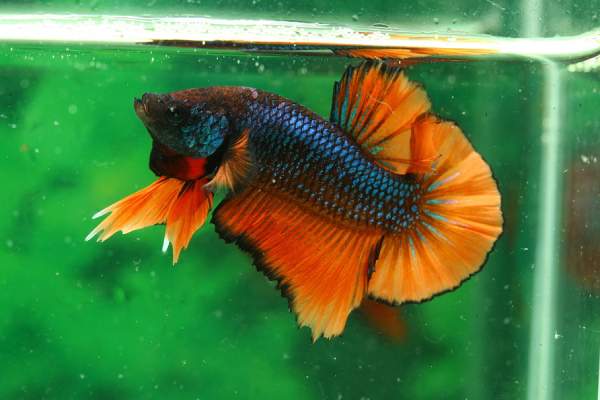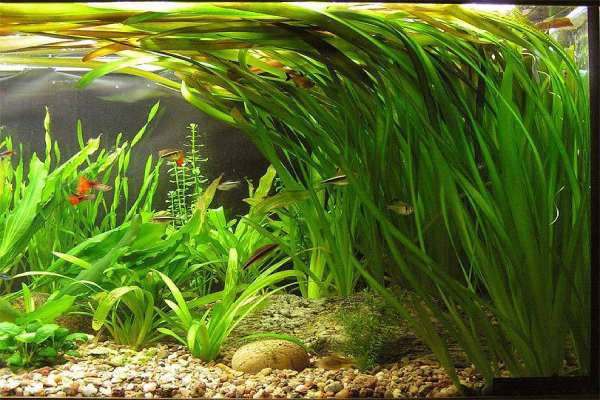Koi Angelfish – Not Really A Koi Specie
Koi angelfish (Pterophyllum scalare) is a popular freshwater fish that belongs to the cichlid family. Most fish enthusiasts believe that koi angelfish is a koi fish, but the truth is, koi angelfish is not a koi fish.
It is a variant of the common angelfish with unique color patterns reminiscent of the ornamental koi fish found in Japanese gardens.

Koi angelfish are popular among fish keepers because of their attractive look, calm demeanor, and low maintenance needs.
Koi angelfish is one of several angelfish species, but it is distinctive. They are visually striking because of their iridescent coloring and slender bodies.
Koi angelfish are a great option for your aquarium, especially if you are just starting out. Their size and disposition make them a wonderful addition to both community and species-specific aquariums, and their color sets them apart from other angelfish species. Read on to learn some amazing facts about Koi angelfish.
Appearance
Koi angelfish are known for their distinctive color patterns, which resemble those of koi fish. They display numerous colors, including red, yellow, orange, black, and white.
The patterns can vary significantly, with some of them exhibiting solid colors while others possess intricate combinations of spots, stripes, or marbled patterns.
The long, triangular dorsal and anal fins flow smoothly, giving the fish a sophisticated look. Koi angelfish typically reach a height of approximately 6 inches (15 cm), while some may reach as much as 8 inches (20 cm).
Temperament
Koi angelfish have an easygoing temperament and get along well with other fish, making them a good choice for community aquariums. Tankmates and the size of the aquarium can all play a role in determining how they act.
You can keep them with other peaceful fish, but they should not be kept with aggressive or fin-nipping fish. The aquarium should have a lot of foliage and hiding places for them.
Habitat
Koi angelfish is found naturally only in the Amazon River and its tributaries in South America. They prefer calm rivers and flooded forest areas.
In their natural environment, the water is often warm, gentle, and mildly acidic. A pH level between 6.5 and 6.9 and a temperature of 76 to 84 degrees Fahrenheit (24°C and 28°C) are ideal for wild angel koi kept in captivity.
Those raised in captivity can flourish at pH levels up to 7.8. They like to be kept in an aquarium with lots of plants and driftwood, just like in the wild.
Feeding
Koi angelfish have a varied diet because they are omnivores. In the wild, their staple diet consists of crustaceans and insect larvae. In captivity, they eat premium flake or pellet food designed specifically for angelfish.
Live or frozen bloodworms, brine shrimp, and daphnia are great options to supplement their diet with the necessary nutrients. To further encourage a balanced diet, you can try serving them blanched vegetables like spinach or peas occasionally.
Breeding
Breeding koi angelfish can be a rewarding experience for fish keepers. However, it’s crucial to have a compatible breeding partner before you try to breed.
Angelfish form monogamous pairs, so it is recommended that you keep a group of young angelfish together and allow them to pair off on their own. Once a pair has formed, you can separate them into a breeding tank.
The ideal conditions for a breeding tank are enough space, good filtration, and mildly acidic water. To promote spawning, the water temperature can be elevated to about 80 degrees Fahrenheit (27 degrees Celsius).
Usually, the pair will pick a broad leaf or a piece of slate, both of which are rather flat, to lay their eggs on. Several hundred eggs are laid by the female, which are fertilized by the male. You can take the parents out of the breeding tank right after spawning.
Depending on the temperature of the water, the eggs will hatch in about 48 to 60 hours. Once the eggs hatch, the fry will attach themselves to the spawning site using adhesive glands on their heads.
At this early stage, they are dependent on the yolk sacs for nourishment. Fry can be fed infusoria or finely broken flake food once they are free swimming, which happens after a few days.
Fry are extremely vulnerable to changes in water quality and temperature during the breeding phase. Sponge filters and frequent water changes help keep the environment steady for the developing fry.
The fry will go through a number of developmental stages as they grow, and it could be several months before they reach adult size and have the distinctive angelfish fin form. They often display a wide range of color patterns and variances, which often shift as they get older.
Varieties
Koi angelfish are known for their captivating colors and patterns. Selective breeding has allowed for the development of many new and interesting varieties over the years. Popular varieties of Koi angelfish include;
Classic Koi Angelfish
Classic koi angelfish have a white or silver body with bold black spots or blotches on the scales. The name “Koi” comes from the fact that the patterns are similar to those seen on traditional Koi fish.
Marble Koi Angelfish
This variety displays a marbled pattern with intricate mixtures of black, white, and other colors. The marbling can look very different on each of them, making each fish unique.
Gold Koi angelfish
The body of a gold koi angelfish is mostly yellow or gold, with black patterning. The striking appearance is a result of the contrast between the gold and the black.
Ghost Koi Angelfish
Ghost Koi angelfish do not have pigment, making them look transparent or translucent. Their thin skin makes it easy to see their skeleton and internal organs.
Zebra Koi Angelfish
The Zebra Koi angelfish are distinguished by their silver or white bodies with pronounced black vertical stripes. The strips look more like zebras, hence the name “Zebra Koi Angelfish”.
Blushing Koi Angelfish
Koi angelfish with a light pink or peach blush on their gill covers and, in certain cases, their fins are known as blushing angelfish. Their overall style is elevated by this special detail.
You can find many more varieties of Koi angelfish than those discussed here. You can choose which species you like most because they all have their own unique beauty and charm.
Conclusion
Koi angelfish are gorgeous, attention-grabbing freshwater fish with unique patterning. Because of their calm demeanor, they can coexist with other fish in community tanks.
To ensure their well-being, it is important to recreate their natural habitat by providing appropriate water conditions and a varied diet.
Taking your time to breed Koi angelfish can be enjoyable, but only if you can maintain good water quality and the proper temperature. Koi angelfish, if given the right conditions, are hardy and beautiful additions to any aquarium.
Read Also: Koi Fish Tail Anatomy [Exploring Koi Fins & Tail]
FAQs
Yes, you can keep koi angelfish in a community aquarium with other peaceful fish species.
Koi Angelfish can do best in water that is between 76 to 84 degrees Fahrenheit (24°C and 28°C)
Koi angelfish are omnivorous. They can eat premium flake or pellet food made specifically for angelfish, along with live or frozen bloodworms and brine shrimp. Feeding them vegetables and fruits every once in a while could also be helpful.


![Orange Koi Fish - Koi With Orange Markings [Pictures]](https://aquifacts.com/wp-content/uploads/2024/03/orange-koi-fish_1.jpg)


![Koi Fish Tail Anatomy [Exploring Koi Fins & Tail]](https://aquifacts.com/wp-content/uploads/2024/03/koi-fish-tail-anatomy_img.jpg)
![White Koi Fish [Japanese Koi Fish Varieties]](https://aquifacts.com/wp-content/uploads/2024/03/white-koi-fish_img.jpg)